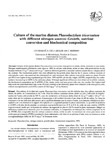| dc.contributor.author | Fidalgo Paredes, Pablo | |
| dc.contributor.author | Cid, Ángeles | |
| dc.contributor.author | Abalde, Julio | |
| dc.contributor.author | Herrero, Concepción | |
| dc.date.accessioned | 2014-12-10T16:49:45Z | |
| dc.date.available | 2014-12-10T16:49:45Z | |
| dc.date.issued | 1995 | |
| dc.identifier.citation | Fidalgo JP, Cid A, Abalde J, Herrero C. Culture of the marine diatom phaeodactylum tricornutum with different nitrogen sources: Growth, nutrient conversion and biochemical composition. Cah Biol Mar. 1995;36(3):165-73 | es_ES |
| dc.identifier.uri | http://hdl.handle.net/2183/13849 | |
| dc.description.abstract | [Abstract] Cultures of the marine diatom Phaeodaetylum trieornutum were grown in nitrate, nitrite, ammonia or urea media.
Nitrogen transformation efficiencies were close to 100% in cultures with nitrate, nitrite or urea, with productivities in dry
biomass between 2.2 g.l-1 (urea) and 2.8 g.t1 (nitrate). However growth in ammonia cultures ceased due to a drop in pH of
the medium. The biochemical profile was more affected by the growth phase than by the N source. Cellular contents of
chlorophylls a and e decreased and the chlorophyll ale ratio increased when cultures entered the stationary phase. Protein
and RNA were higher during exponential growth (about 30% and 8% ash free dry weight (AFDW), respectively), but carbohydrates
increased up to 220% in the stationary phase. Although significant differences were observed in cellular contents,
the biochemical composition (as % AFDW) of the nitrate, nitrite and urea-grown cells was very similar. The highest total
fatty acids and polyunsaturated fatty acids (PUFAs) contents in the stationary phase were obtained in the urea-grown cells,
with an eicosapentaenoic acid (EPA) content of 26.8 mg.g-1 of dry biomass. | es_ES |
| dc.description.abstract | [Résumé] Des cultures de la diatomee marine Phaeodaetylum trieornutum ont ete realisees dans des milieux contenant du
nitrate, du nitrite, de l'ammonium ou de l'uree. Dans les milieux contenant nitrate, nitrite ou uree, l'efficacite de transformation
de l'azote a ete proche de 100 ok, avec des rendements en biomasse seche allant de 2,2 g.l-1 (uree) a 2,8 g.t1 (nitrate),
alors que la croissance en presence d'ammonium a ete inhibee a la suite d'une chute de pH du milieu. La phase de
croissance a eu une influence plus grande sur Ie profil biochimique que la source d'azote. Les contenus cellulaires en chlorophylle
a et e ont diminue et Ie rapport chlorophylle a Ie a augmente pendant la phase stationnaire. La quantite de proteines
et d' ARN a ete plus elevee pendant la croissance exponentielle (environ 30 % et 8 % du poids sec ·sans cendres (AFDW)
respectivement), tandis que les hydrates de carbone ont augmente de plus de 220 % durant la phase stationnaire. Malgre les
differences significatives observees pour les contenus cellulaires, la composition biochimique des cellules (exprimee en %
de AFDW) etait comparable dans les milieux contenant nitrate, nitrite ou uree. Le maximum en acides gras totaux et en
acides gras polyinsatures (PUFAs) pendant la phase stationnaire a ete observe en presence d'uree, avec un contenu en acide
eicosapentaenolque (EPA) de 26.78 mg.g-1 de biomasse seche. | es_ES |
| dc.description.sponsorship | Consejo Interinstitucional de Ciencia y Tecnología; n° AGF920736 | es_ES |
| dc.language.iso | eng | es_ES |
| dc.publisher | Station Biologique de Roscoff | es_ES |
| dc.relation.uri | http://www.sb-roscoff.fr/ | es_ES |
| dc.subject | EPA | es_ES |
| dc.subject | Phaeodaetylum | es_ES |
| dc.subject | Nitrogen sources | es_ES |
| dc.subject | Growth phase | es_ES |
| dc.subject | Biochemical composition | es_ES |
| dc.title | Culture of the marine diatom Phaeodactylum tricornutum with different nitrogen sources: Growth, nutrient conversion and biochemical composition | es_ES |
| dc.type | info:eu-repo/semantics/article | es_ES |
| dc.rights.access | info:eu-repo/semantics/openAccess | es_ES |






